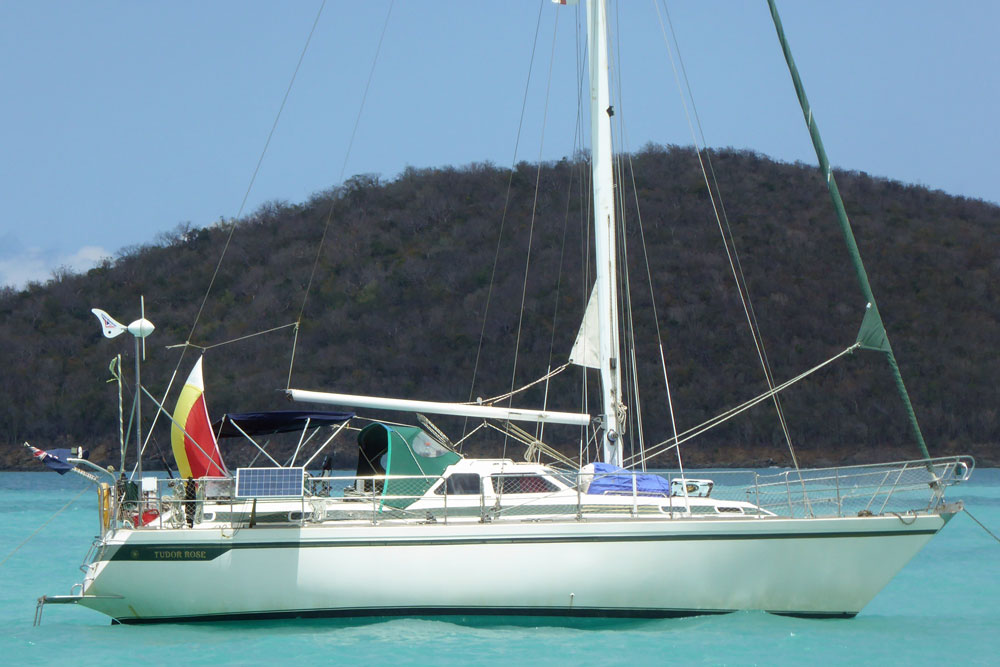- Home
- Cruising Yachts 35' to 40'
- Colvic Countess 37
The Colvic Countess 37 Sailboat
The Colvic Countess 37 Centre-Cockpit Cutter was designed by Ian Anderson and built in the UK by Colvic Craft Ltd.
 A Colvic Countess 37 with a furling headsail, a hanked-on staysail and an in-mast furling mainsail
A Colvic Countess 37 with a furling headsail, a hanked-on staysail and an in-mast furling mainsailPublished Specification for the Colvic Countess 37
Underwater Profile: Fin keel with balanced rudder
Hull Material: GRP (Fiberglass)
Length Overall: 37'5" (11.4m)
Waterline Length: 29'6" (9.0m)
Beam: 12'10" (3.9m)
Draft: 5'7" (1.7m)
Rig Type: Cutter
Displacement: 19,048lb (8,640kg)
Designer: Ian Anderson
Builder: Colvic Craft (UK)
Year First Built: 1986
Published Design Ratios for the Colvic Countess 37
Sail Area/Displacement Ratio: not available
Ballast/Displacement Ratio: 40.5
Displacement/Length Ratio: 330
Comfort Ratio: 31.0
Capsize Screening Formula: 1.9
read more about these all-revealing numbers...
Summary Analysis of the Design Ratios for the Colvic Countess 37
1. The Sail Area/Displacement Ratio for the Colvic Countess 37 has not been published.
2. A Ballast/Displacement Ratio of 40.5 means that the Colvic Countess 37 will initially stand up reasonably well to her canvas in a moderate breeze, but she'll need a reef in the main to avoid heeling excessively in a gust.
3. A Displacement/Length Ratio of 330, tells us the Colvic Countess 37 is clearly a heavy displacement cruising boat. You can load her down with all your cruising gear and equipment and it will hardly affect her waterline. Not an ideal choice for coastal sailing, but she'll come into her own on an offshore passage in testing conditions.
4. Ted Brewer's Comfort Ratio of 31.0 suggests that crew comfort of a Colvic Countess 37in a seaway is similar to what you would associate with the motion of a moderate bluewater cruising boat - a predictable and acceptable motion for most seasoned sailors.
5. The Capsize Screening Formula (CSF) of 1.9 tells us that a Colvic Countess 37 would be a safer choice of sailboat for an ocean passage than one with a CSF of more than 2.0.
Colvic Countess 37: A Spacious and Comfortable Cruiser
The Colvic Countess 37 is a fiberglass sloop or ketch with a long fin keel and a skeg-hung rudder. It has a spacious cockpit with a single wheel steering and a large aft deck. The boat has a generous beam of 12 feet and a draft of 5 feet 6 inches. It has a displacement of 17,000 pounds and a ballast of 6,500 pounds. The boat can carry up to 100 gallons of water and 50 gallons of fuel.
The Colvic Countess 37 has a masthead rig with a deck-stepped mast and swept-back spreaders. The sloop version has a sail area of 650 square feet, while the ketch version has a sail area of 750 square feet. The boat can be equipped with various sail options, such as roller furling genoa, in-mast or in-boom reefing mainsail, mizzen sail, spinnaker or cruising chute. The boat has a powerful engine, usually a Perkins 4108 diesel that delivers 50 horsepower.
Accommodation
One of the main attractions of the Colvic Countess 37 is its spacious and comfortable interior. The boat can accommodate up to six people in three separate cabins. The forward cabin has a V-berth with storage underneath and a hanging locker. The aft cabin has a double berth with storage and a hanging locker. The saloon has a U-shaped dinette that converts into a double berth and a settee that can be used as a single berth. The saloon also has a large table, shelves, lockers and a stereo system.
The boat has two heads, one forward and one aft, both with marine toilets, sinks and showers. The forward head is accessible from the forward cabin and the saloon, while the aft head is accessible from the aft cabin and the cockpit. The boat has a well-equipped galley with a three-burner stove with oven, a refrigerator, a freezer, a double sink and ample storage space. The boat also has a navigation station with a chart table, instruments and electrical panel.
Hull and Deck
The hull of the Colvic Countess 37 is made of solid fiberglass with no core material. It is reinforced with stringers and bulkheads for extra strength and rigidity. The hull has a white gelcoat finish with blue stripes and cove lines. The deck is made of fiberglass with balsa core for stiffness and insulation. It has molded-in nonskid surfaces for safety and traction. The deck also has teak handrails, toe rails and trim for aesthetic appeal.
The deck of the Colvic Countess 37 is well laid out for sailing and cruising. It has wide side decks for easy movement around the boat. It has two large anchor lockers at the bow with electric windlass and bow roller. It has six mooring cleats and fairleads for secure docking. It has two dorade vents for ventilation. It has two large lazarettes at the stern for storing gear and equipment. It has stainless steel stanchions, lifelines and pulpits for safety.
The cockpit of the Colvic Countess 37 is spacious and comfortable. It has an L-shaped seating area with cushions and storage underneath. It has a pedestal-mounted wheel steering with engine controls, compass and instruments. It has an instrument pod above the companionway with wind, speed, depth and autopilot displays. It has a folding cockpit table for dining al fresco. It has an aft deck with davits for dinghy storage.
Mast and Rigging
The mast of the Colvic Countess 37 is made of aluminum alloy with stainless steel fittings. It is deck-stepped on a compression post that transfers the load to the keel. It has internal halyards that run through exit boxes at the mast base. It has an anodized finish for corrosion resistance.
The rigging of the Colvic Countess 37 is made of stainless steel wire with swaged terminals. It consists of upper and lower shrouds, forward and aft lower shrouds, forestay, backstay and mizzen stay (for the ketch version). It has turnbuckles for tension adjustment and chainplates for attachment to the hull. It has a boom vang for mainsail shape control.
The sails of the Colvic Countess 37 are made of dacron or other synthetic materials. They include a mainsail, a genoa, a mizzen sail (for the ketch version) and optional sails such as spinnaker, cruising chute or storm jib. The mainsail has battens, reef points and a sail cover. The genoa has a roller furling system for easy handling. The mizzen sail has a sail cover and a topping lift. The sails are controlled by winches, blocks, cleats and lines.
Keel and Rudder
The keel of the Colvic Countess 37 is a long fin keel that provides stability, performance and directional control. It is made of cast iron with lead ballast. It is bolted to the hull with stainless steel bolts and nuts. It has a hydrodynamic shape that reduces drag and improves speed. It has a draft of 5 feet 6 inches that allows the boat to access shallow waters.
The rudder of the Colvic Countess 37 is a skeg-hung rudder that provides steering and balance. It is made of fiberglass with a stainless steel stock and pintles. It is attached to the skeg that protects it from damage and improves its effectiveness. It has a balanced design that reduces the helm pressure and improves the maneuverability. It is connected to the wheel steering by cables and pulleys.
This article was written with the assistance of Gemini, a large language model developed by Google. Gemini was used to gather information, summarize research findings, and provide suggestions for the content and structure of the article.
Recent Articles
-
Modern Boat Electronics and the Latest Marine Instruments
Dec 20, 25 05:27 PM
Should sailboat instruments be linked to the latest boat electronics as a fully integrated system, or is it best to leave them as independent units? -
Hans Christian 43: Classic Bluewater Cruiser & Liveaboard Sailboat
Dec 10, 25 04:37 AM
Explore the Hans Christian 43: a legendary heavy-displacement, long-keel sailboat. Read our in-depth review of its specs, design ratios, and suitability for offshore cruising and living aboard. -
Planning Your Sailboat Liveaboard Lifestyle: An Ocean Sailor's Guide
Dec 06, 25 05:18 AM
Seasoned sailors share their methodical risk analysis for planning a secure Sailboat Liveaboard Lifestyle, covering financial, property, and relationship risks.













